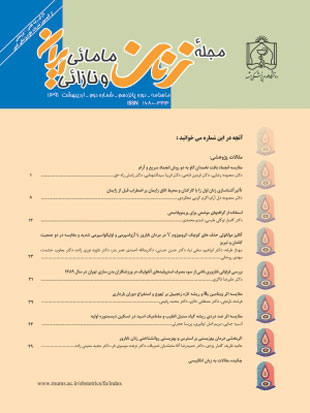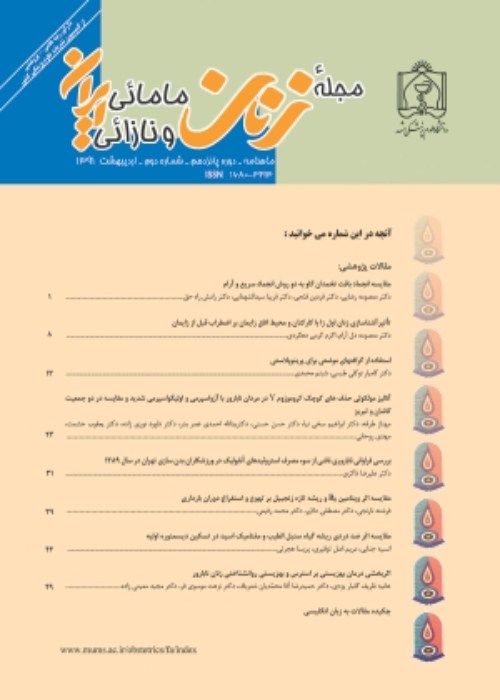فهرست مطالب

مجله زنان مامائی و نازائی ایران
سال شانزدهم شماره 86 (هفته چهارم بهمن 1392)
- تاریخ انتشار: 1392/12/03
- تعداد عناوین: 3
-
-
صفحات 1-5مقدمهسرطان پستان، شایعترین سرطان زنان در جهان و ایران و بیشترین علت مرگ و میر ناشی از سرطان در زنان ایرانی می باشد. تعداد قابل توجهی از بیماران مبتلا به سرطان پستان در سیر بیماری خود دچار متاستاز شده که عامل مهمی در شکست درمان، عوارض و مرگ و میر بیماران می باشد. مطالعه حاضر با هدف مقایسه وضعیت بیماران مبتلا به سرطان پستان در موقعیت متاستاتیک و غیر متاستاتیک انجام شد.روش کاردر این مطالعه توصیفی تحلیلی، پرونده 1615 زن مبتلا به سرطان پستان مراجعه کننده به بیمارستان امید مشهد طی سال های 90-1380 مورد ارزیابی قرار گرفت که از این تعداد، 446 بیمار به سرطان پستان متاستاتیک مبتلا بودند. چک لیست اطلاعات با توجه به پرونده هر بیمار تکمیل شد. تجزیه و تحلیل داده ها با استفاده از نرم افزار آماری SPSS (نسخه 16) و آزمون های آماری کای دو و تی تست انجام شد. میزان p کمتر از 05/0 معنی دار در نظر گرفته شد.یافته هااز 446 بیمار مبتلا به سرطان پستان متاستاتیک، 100 بیمار (4/22%) از بدو مراجعه دارای متاستاز و 346 بیمار (6/77%) طی درمان یا پیگیری دچار متاستاز شدند. بیشترین میزان متاستاز در استخوان (1/45%) و پس از آن کبد (20%) بود. یافته های ایمونوهیستوشیمی نشان داد که در متاستاز مغز و کبد، اکثر موارد Her-2 مثبت بوده در حالی که در متاستازهای استخوان، اکثر بیماران Her-2 منفی بودند. بین دو گروه مورد مطالعه از نظر وضعیت قاعدگی، مکان متاستاز، میزان مثبت شدن گیرنده های هورمونی (استروژن و پروژسترون) و Her-2 ارتباط معنی داری وجود نداشت.نتیجه گیریبیشترین موارد متاستاز سرطان پستان، استخوان می باشد (در اکثر این بیماران Her-2 منفی و گیرنده های هورمونی مثبت می باشند) اما در بیشتر بیماران دارای متاستازهای مغزی و کبدی، Her-2 مثبت بوده که در این ها پروگنوز بیماری بدتر می باشد و نیاز به توجه خاص برای استفاده از رژیم های درمانی مناسب خواهد بود.
کلیدواژگان: سرطان پستان، گیرنده استروژن، گیرنده پروژسترون، متاستاز، Her، 2 -
صفحات 6-8مقدمهآنژیومیوفیبروبلاستوم، یک تومور نادر خوش خیم است که تظاهراتی مشابه آنژیومیکسوم از خود نشان می دهد. این تومور، یک تومور بافت نرم است که غالبا در ناحیه ولو زنان پره منوپوز رخ می دهد. اکثر بیماران با توده ولو مراجعه می کنند که اغلب تشخیص بالینی کیست بارتولن داده می شود و تشخیص افتراقی آن از آنژیومیکسوم مهاجم و میکسوفیبروسارکوم اهمیت دارد. مطالعه حاضر با هدف گزارش یک مورد نادر آنژیومیوفیبروبلاستوم واژن در خانمی 36 ساله انجام شد.
گزارش مورد: بیمار خانمی 36 ساله بود که در سال 1384 (8 سال قبل) به دلیل احساس توده در ناحیه واژن به درمانگاه انکولوژی زنان مراجعه کرده بود. طبق اظهارات بیمار رشد توده مذکور کند و بطئی بوده و به علت فقدان مشکل خاص پیگیری نکرده، اما طی 2 سال اخیر، توده کمی بزرگتر شده و به دلیل ایجاد اشکال در هنگام مقاربت، بیمار مراجعه کرده بود. در معاینه اولیه، توده های کروی شکل و منشا گرفته از قسمت تحتانی واژن در سمت چپ با برجستگی بیشتر در ناحیه فورشت، قابل دید و لمس بود. حذف ساده تومور انجام شد. ماکروسکوپی ضایعه، نشانگر یک قطعه بافت کروی شکل، دارای بافت مخاطی، در برش توپر به رنگ کرم و با قوام نرم بود. گزارش میکروسکوپی موید آنژیومیوفیبروبلاستوم بود. پس از حذف ساده تومور، طی 84 ماه پیگیری (7 سال) تاکنون عود موضعی یا سیستمیکی مشاهده نشده است.نتیجه گیریآنژیومیوفیبروبلاستوم در خارج از ولو و در سنین کمتر از میانسالی هم می تواند رخ دهد و حذف ساده تومور درمان علاج بخش آن می باشد.
کلیدواژگان: آنژیومیوفیبروبلاستوم، آنژیومیکسوم، واژن -
صفحات 9-15مقدمه
در بین عوامل موثر بر تضعیف عضلات کف لگن، بارداری و زایمان طبیعی، به عنوان مهمترین عوامل خطر بی اختیاری های دفعی محسوب می شوند. با توجه به تناقض نتایج مطالعات موجود در مورد تاثیر روش زایمان بر بی اختیاری ادراری و مدفوعی، مطالعه حاضر با هدف بررسی شیوع بی اختیاری ادراری و روده ای پس از زایمان و عوامل مرتبط با آن انجام شد.
روش کاراین مطالعه مقطعی در سال 91-1390 بر روی 429 زن ساکن شهر خلخال که 4 ماه از زایمان آنها گذشته بود، در مراکز بهداشتی سطح شهر خلخال انجام شد. نمونه گیری به روش در دسترس انجام شد. ابزار گردآوری داده ها پرسشنامه حاوی اطلاعات جمعیت شناختی و پرسشنامه سندویک در مورد علائم بی اختیاری ادراری، مدفوعی و گازهای روده ای بود. داده ها پس از گردآوری با استفاده از نرم افزار آماری SPSS (نسخه 20) و آزمون های تی مستقل، کای اسکوئر و همبستگی مورد تجزیه و تحلیل قرار گرفت. میزان p کمتر از 05/0 معنی دار در نظر گرفته شد.
یافته هاشیوع بی اختیاری ادراری و گازهای روده ای در کسانی که زایمان سزارین داشتند به ترتیب 4/1% و 9/0 % و کسانی که زایمان طبیعی داشتند 9/1% و 4/1% بود که این تفاوت از نظر آماری معنی دار نبود (05/0<p). همچنین بین بی اختیاری ادراری و گازهای روده ای با سن مادر، تعداد بارداری، اپی زیاتومی، پارگی واژینال، تعداد زایمان سزارین و طبیعی، وزن هنگام تولد نوزاد و دور سر نوزاد، ارتباط آماری معنی داری یافت نشد (05/0<p).
نتیجه گیریروش زایمان و تکنیک های مامایی بر بروز بی اختیاری ادراری، مدفوعی و گازهای روده ای در زنان در فاصله زمانی 4 ماه پس از زایمان تاثیری ندارد.
کلیدواژگان: بی اختیاری ادراری، بی اختیاری مدفوعی، زایمان، عوامل خطر
-
Pages 1-5IntroductionBreast cancer is the most common cause of death among Iranian women. A significant number of breast cancer patients are involved metastasis that is an important factor in treatment failure، morbidity and mortality of patients. The aim of present study was comparison of metastatic and non-metastatic breast cancer patients.MethodsIn this analytical descriptive study، 1615 files of patients with breast cancer who referred to Omid hospital in Mashhad، Iran during 2001 to 2011 were evaluated. 446 patients of them were in metastatic status. Checklists were completed according to each patient''s data. Data were analyzed using SPSS software (version 16)، and chi-square test and t-tests. P value less than 0. 05 was considered significant.ResultsIn 446 patients with metastatic breast cancer، 100 patients (22. 4%) had metastasis in the first admission and in 346 patients (77. 6%) metastases developed during the treatment or follow up. The most common sites for metastasis were bone (45. 1%) and liver (20%). Immunohistochemical findings revealed that most of patients with brain and liver metastasis were Her-2 positive whereas the majority of patients with bone metastasis were Her-2 negative. There were no significant relationships between the two groups in terms of menstrual status، location of metastasis، positive rates of estrogen and progesterone receptors and Her-2.ConclusionThe most common site of metastasis is bone (more patients with negative Her-2 and positive hormone receptors) while the common sites for metastasis as far as Her-2 positive is concerned are brain and liver with worse prognosis، concerning special attention for aggressive treatment.Keywords: Breast Neoplasms, Her, 2, Neoplasm Metastasis, Receptors, Estrogen, Receptors, Progesterone
-
Pages 6-8IntroductionAngiomyofibroblastoma is a rare benign tumor that its behaviors are similar to Angiomyxoma. Angiomyofibroblastoma is a soft tissue tumor that often occurs in the vulvar region of premenopausal women. The most patients represent vulvar mass that often diagnosis was confounded with Bartholin’s glandular cyst. It is important that angiomyofibroblastoma distinguish from aggressive angiomyxoma and myxofibrosarcoma. This study presents a rare case of angiomyofibroblastoma of the vagina in a 36 year old woman. Case Report: The subject of the study was a 36 year old woman who has been suffering from a nodule at the orifice of her vagina since 2005 (8 years ago). The lump has grown in the size since 2 years ago. Following the growth of tumor and experiencing discomfort during intercourse the patient consulted with a gynecologist and in the first examination visible spherical lumps based in lower region of vagina at the left and more swelling in fourchette region were observed. Tumor simple removal was done and according to the pathological reports، the removed tumor was in the form of a spherical، solid، soft tissue with light brown color. Histologic examination shows angiomyofibroblastoma. Also، in this patient no systematic or local recurrence was reported after 84 months (7 years) of tumor simple removal.ConclusionIt is important that this neoplasm may occur extra vulvar region and before middle-age and tumor simple removal is the curative treatment.Keywords: Angiomyofibroblastoma, Angiomyxoma, Vagina
-
Pages 9-15Introduction
Among factors related to weakness of pelvic muscles، pregnancy and vaginal delivery are considered as the most important risk factors for fecal incontinence. Because of conflicting results in effect of delivery methods on urinary and intestinal incontinence، this study was designed aim to evaluate the prevalence of urinary and intestinal incontinence in postpartum period and its related factors.
MethodsThis cross-sectional study was conducted on 429 women، 4 month after their delivery in Khalkhal health centers، Iranduring 2011 to 2012. Sampling method was available. Women were asked to complete the demographic questionnaire and a questionnaire about incontinence symptoms that design by Sandvik. Data were analyzed using SPSS software version 20 and t-test، chi-square and correlation tests. P value less than 0. 05 was considered significant.
ResultsPrevalence of urinary and gas incontinence in women with cesarean section was 1. 4% and 0. 9% respectively and in women with vaginal delivery was 1. 9% and 1. 4% respectively that was not statistically significant (p>0. 05). There was no significant association between urinary and gas incontinence and mother age، gravidity، episiotomy، vaginal laceration، number of vaginal delivery and cesarean section، neonatal weight and head circumstance (p>0. 05).
ConclusionThere is no association between method of delivery and urinary and intestinal incontinence 4 month after the delivery.
Keywords: Delivery, Obstetric, Fecal Incontinence, Risk Factors, Urinary Incontinence


